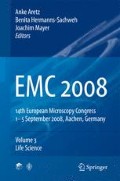Abstract
Hemocyanins are the blue copper-containing respiratory proteins of many molluscs. Nautilus pompilius hemocyanin (NpH) is a cylindrical decamer composed of ten copies of a 350 kDa polypeptide subunit, in turn consisting of seven O2-binding functional units (FUs, termed NpH-a to NpH-g). Ten copies of the subunit segment NpH-a to NpH-f form the cylinder wall (ca. 35 nm in diameter), whereas the ten copies of NpH-g build the internal collar. Recently we published a 9Å cryo-EM structure and molecular model of NpH that solved the principal architecture of this protein [1]. Hemocyanins are highly allosteric, and the cooperativity of oxygen binding should be transferred between functional units by conformational changes. In this context, we try to monitor structural changes caused by the reversible oxygen binding process. Our approach is to prepare the specimens in their fully oxygenated and deoxygenated state, respectively, and to perform independent 3D reconstructions of both states. To achieve this, we developed an automated plunge-freeze apparatus capable of flash freezing the specimen in liquid ethane under controlled atmospheric conditions. Prior to fixation, the molecules are either incubated in an atmosphere with 25 % O2 + 75 % N2 (oxy-state), or in an atmosphere with 100 % N2 (deoxy-state). This led to two independent NpH datasets resulting in two 3D reconstructions with resolutions of 7.8 and 8.4 Å (Figure 1), respectively. Their correlative analysis shows significant structural differences especially concerning the spatial orientation of certain FU types (Figure 2). On the basis of the two resulting molecular models it is now the task to interpret these differences in terms of allosteric interaction mechanisms, but also to reveal possible pitfalls.
Access this chapter
Tax calculation will be finalised at checkout
Purchases are for personal use only
References
Gatsogiannis C, Moeller A, Depoix F, Meissner U, Markl J (2007). Nautilus pompilius hemocyanin: 9 A cryo-EM structure and molecular model reveal the subunit pathway and the interfaces between the 70 functional units. J Mol Biol. 374: 465–86.
Author information
Authors and Affiliations
Editor information
Editors and Affiliations
Rights and permissions
Copyright information
© 2008 Springer-Verlag Berlin Heidelberg
About this paper
Cite this paper
Moeller, A., Gatsogiannis, C., Depoix, F., Meissner, U., Markl, J. (2008). Allosterism of Nautilus pompilius hemocyanin as deduced from 8 Å cryo-EM structures obtained under oxy and deoxy conditions. In: Aretz, A., Hermanns-Sachweh, B., Mayer, J. (eds) EMC 2008 14th European Microscopy Congress 1–5 September 2008, Aachen, Germany. Springer, Berlin, Heidelberg. https://doi.org/10.1007/978-3-540-85228-5_20
Download citation
DOI: https://doi.org/10.1007/978-3-540-85228-5_20
Publisher Name: Springer, Berlin, Heidelberg
Print ISBN: 978-3-540-85227-8
Online ISBN: 978-3-540-85228-5
eBook Packages: Physics and AstronomyPhysics and Astronomy (R0)

